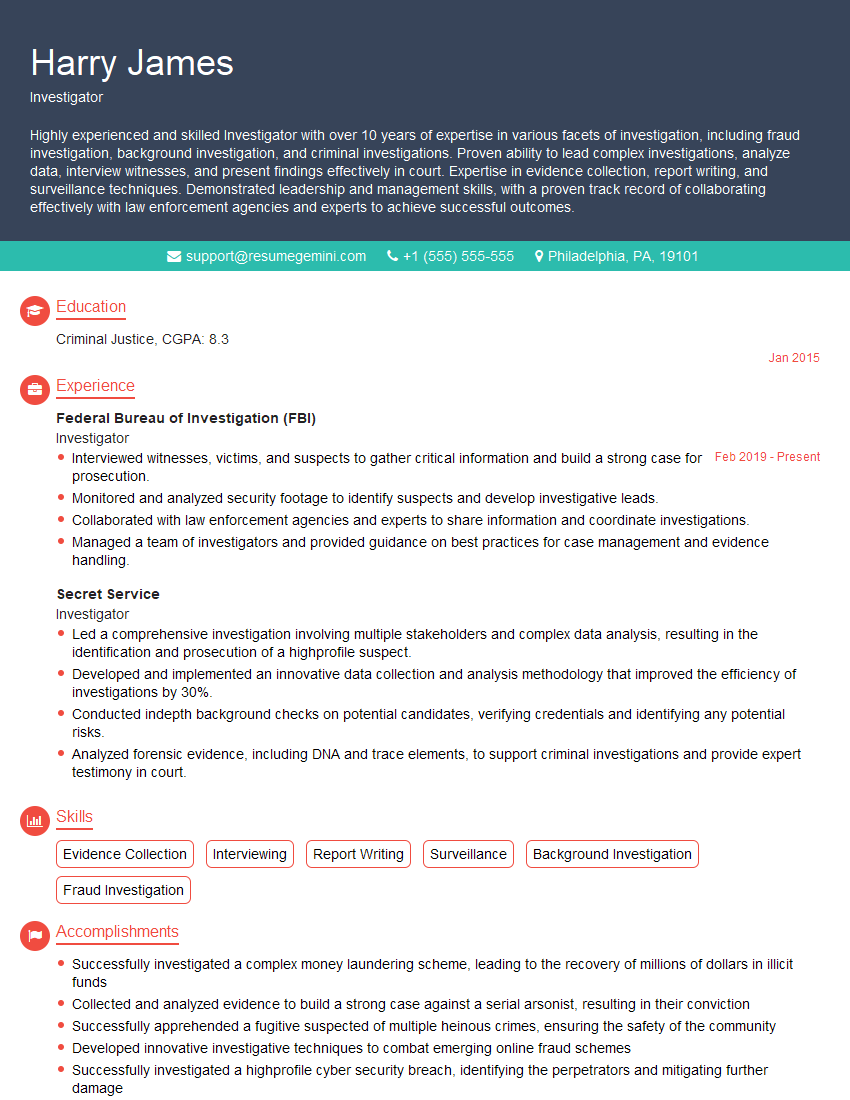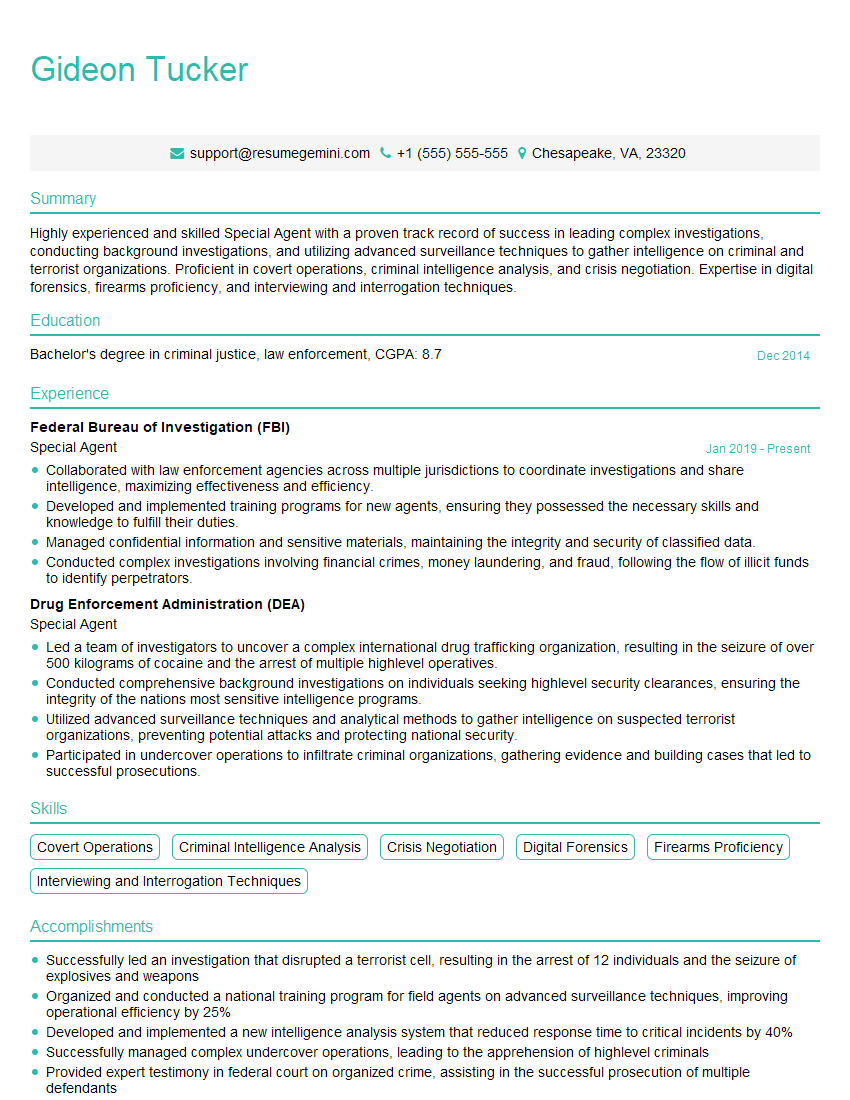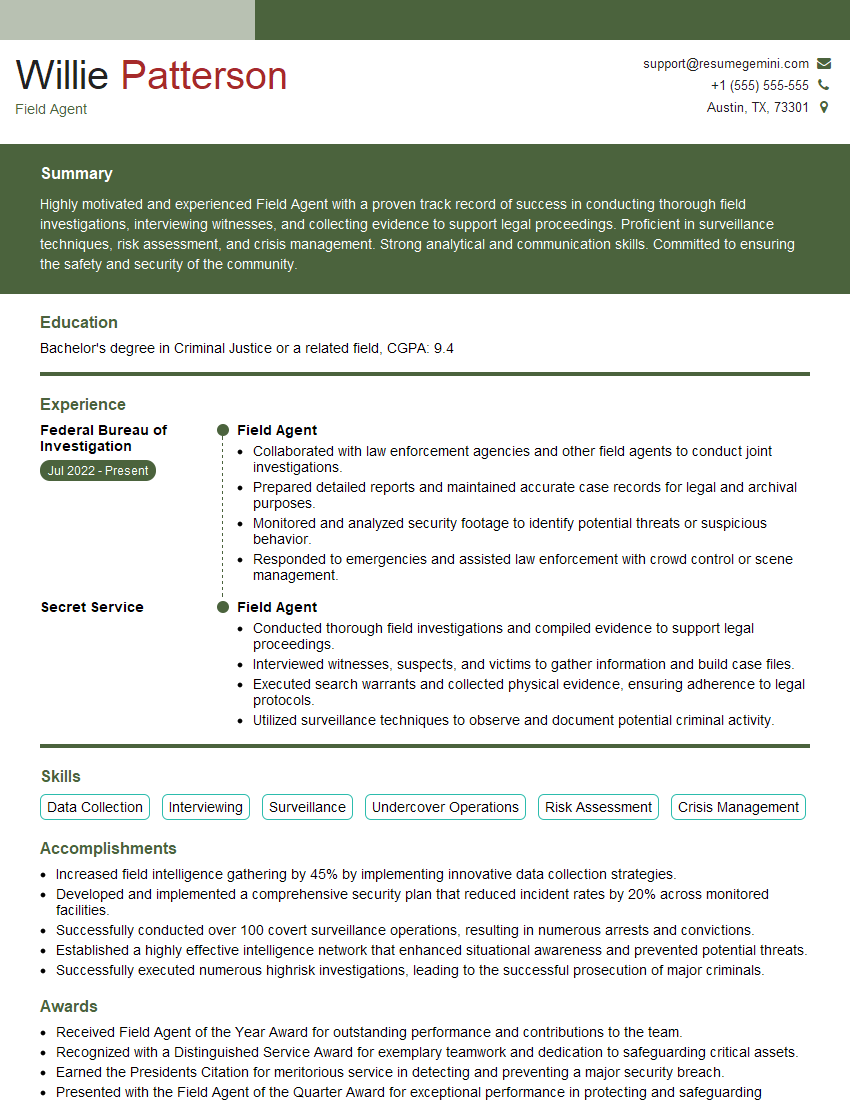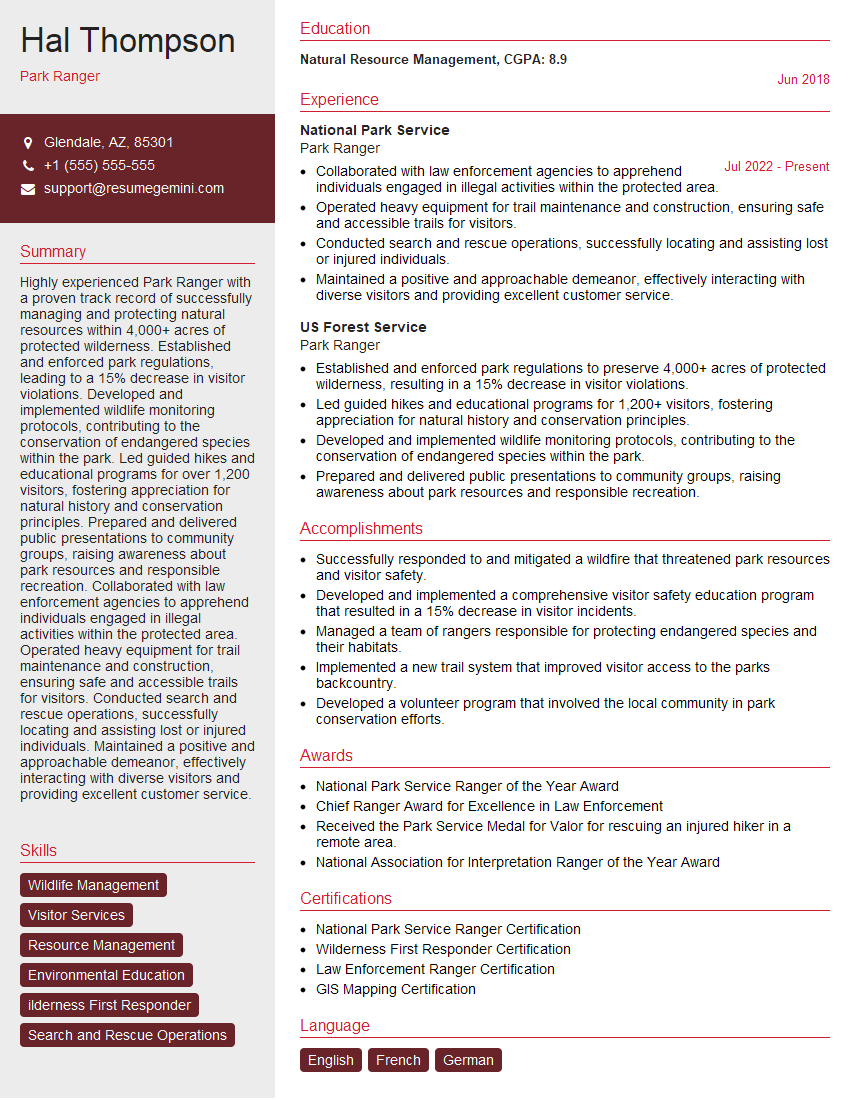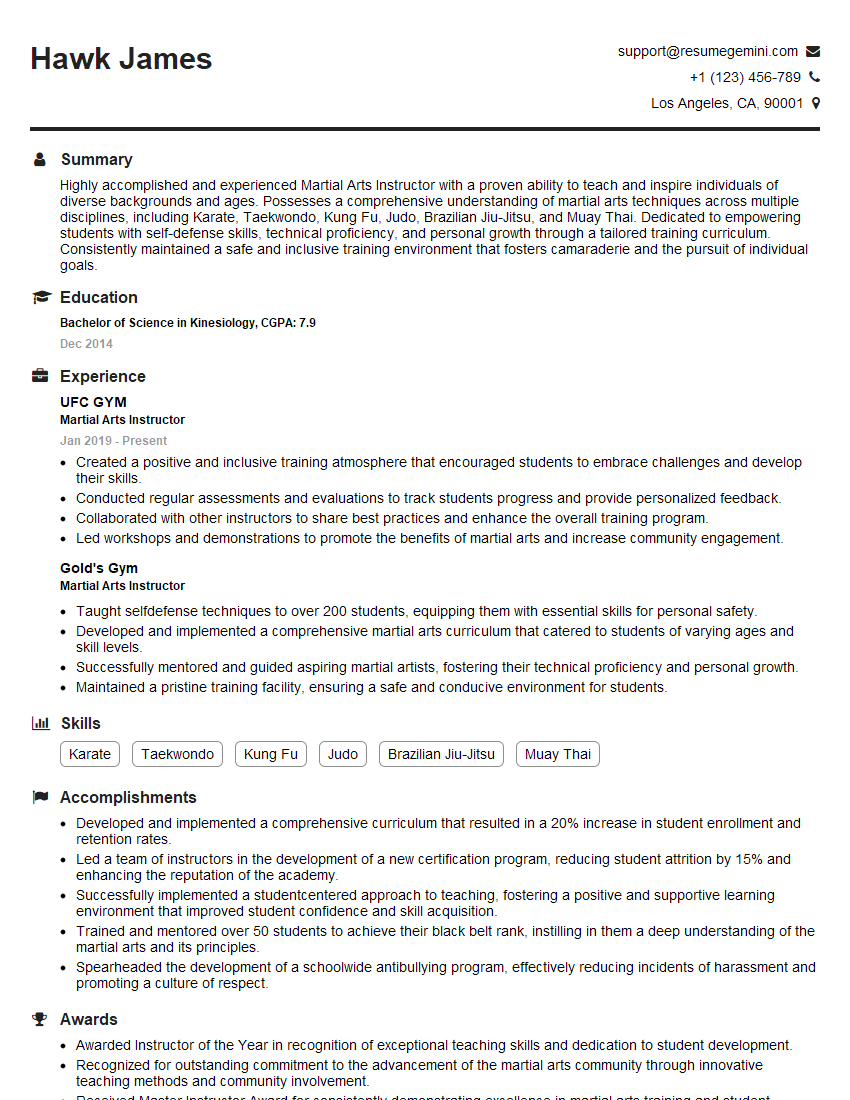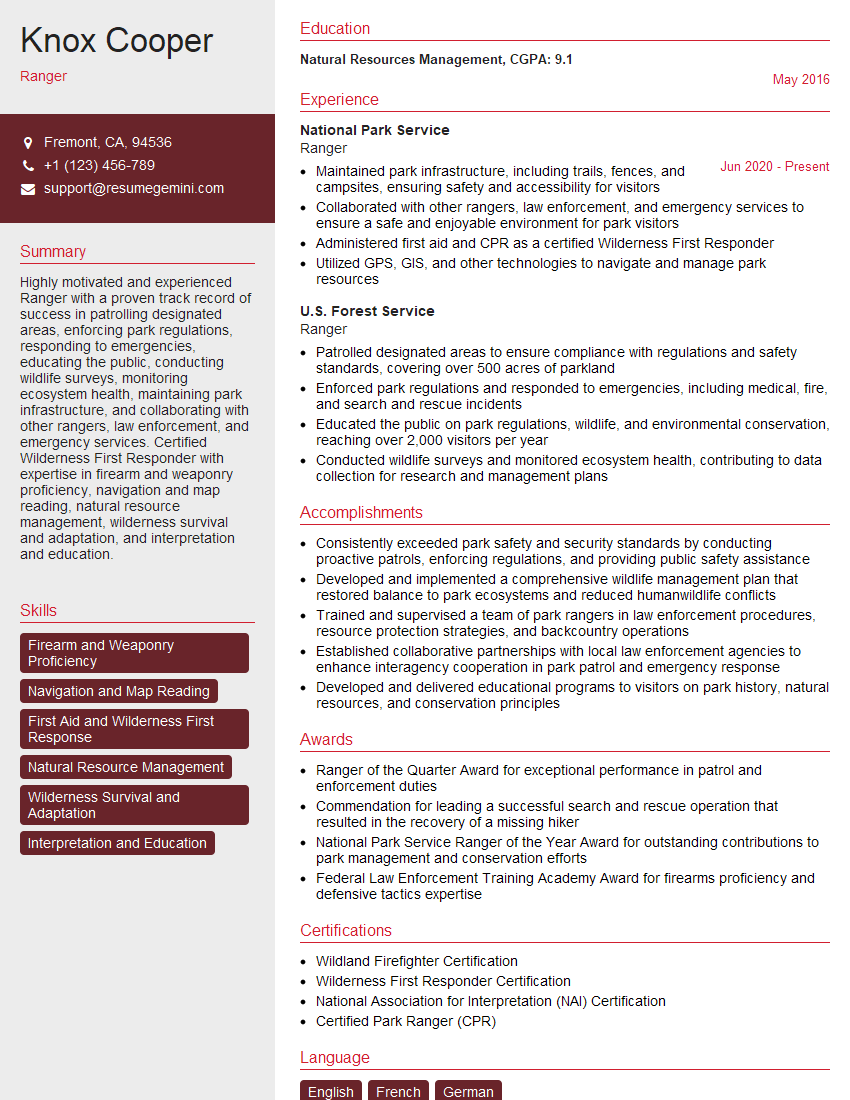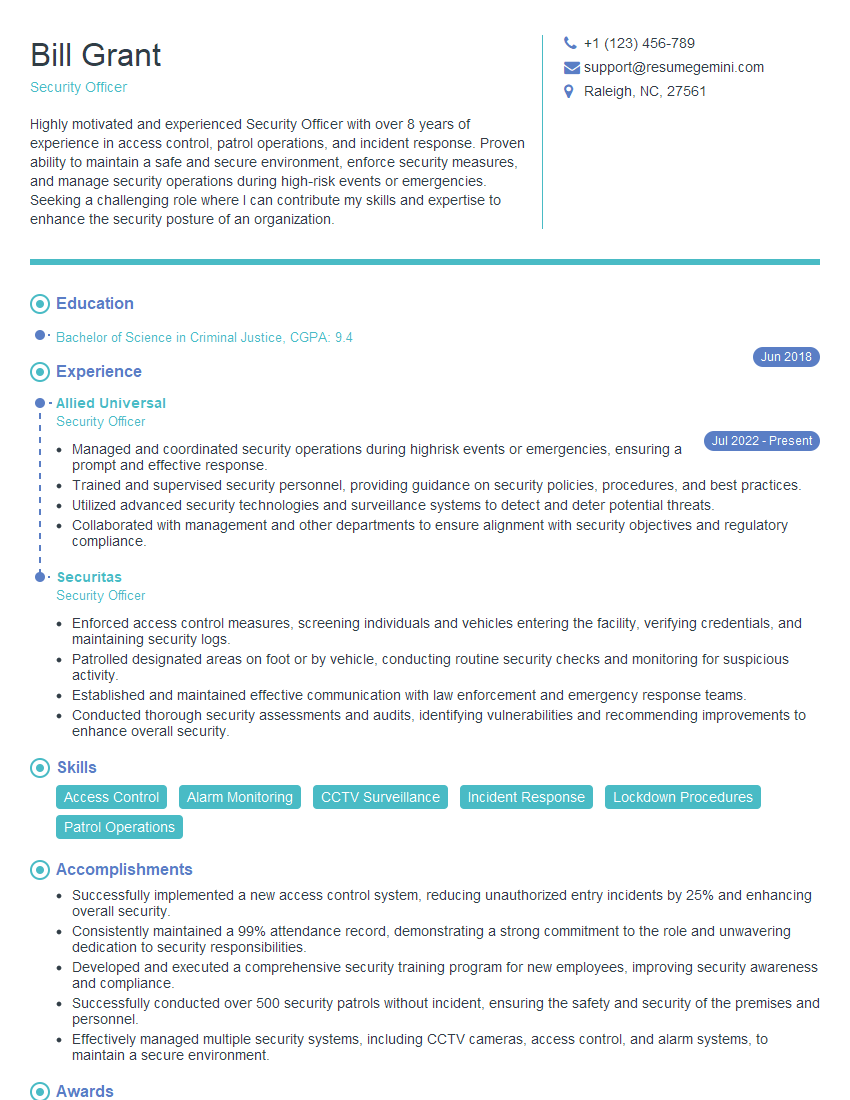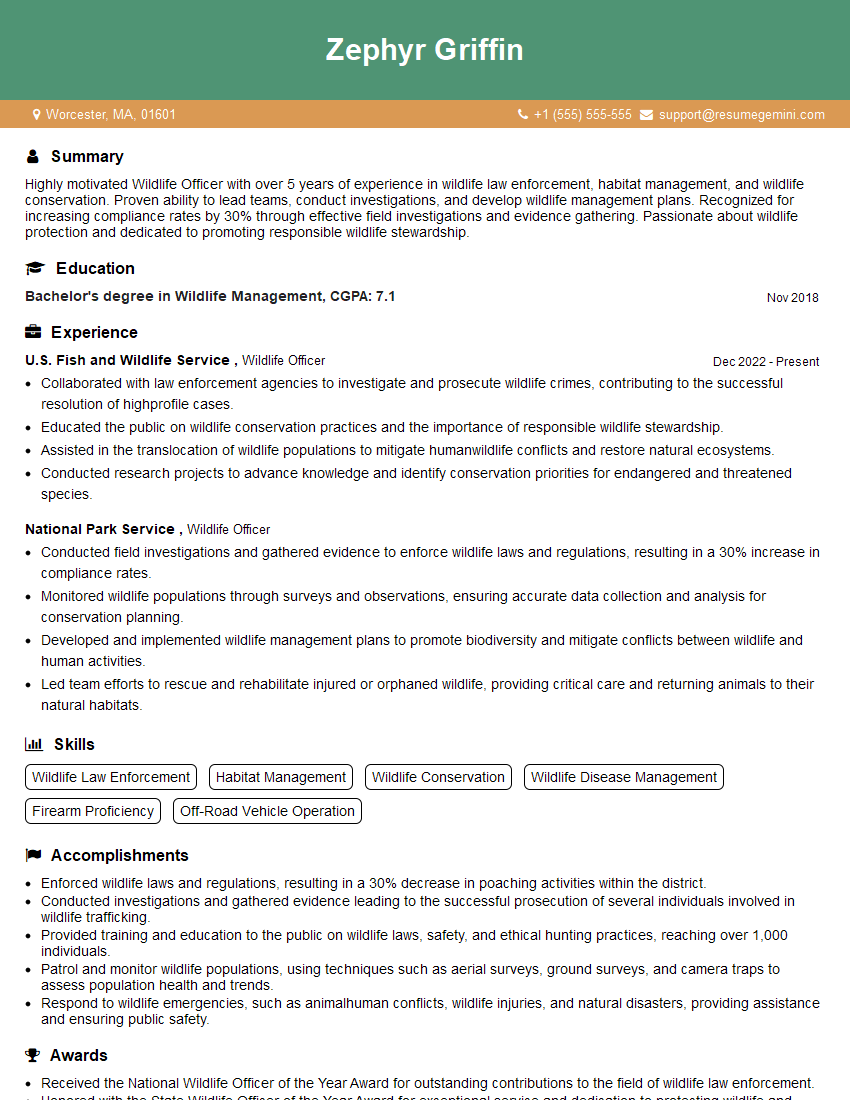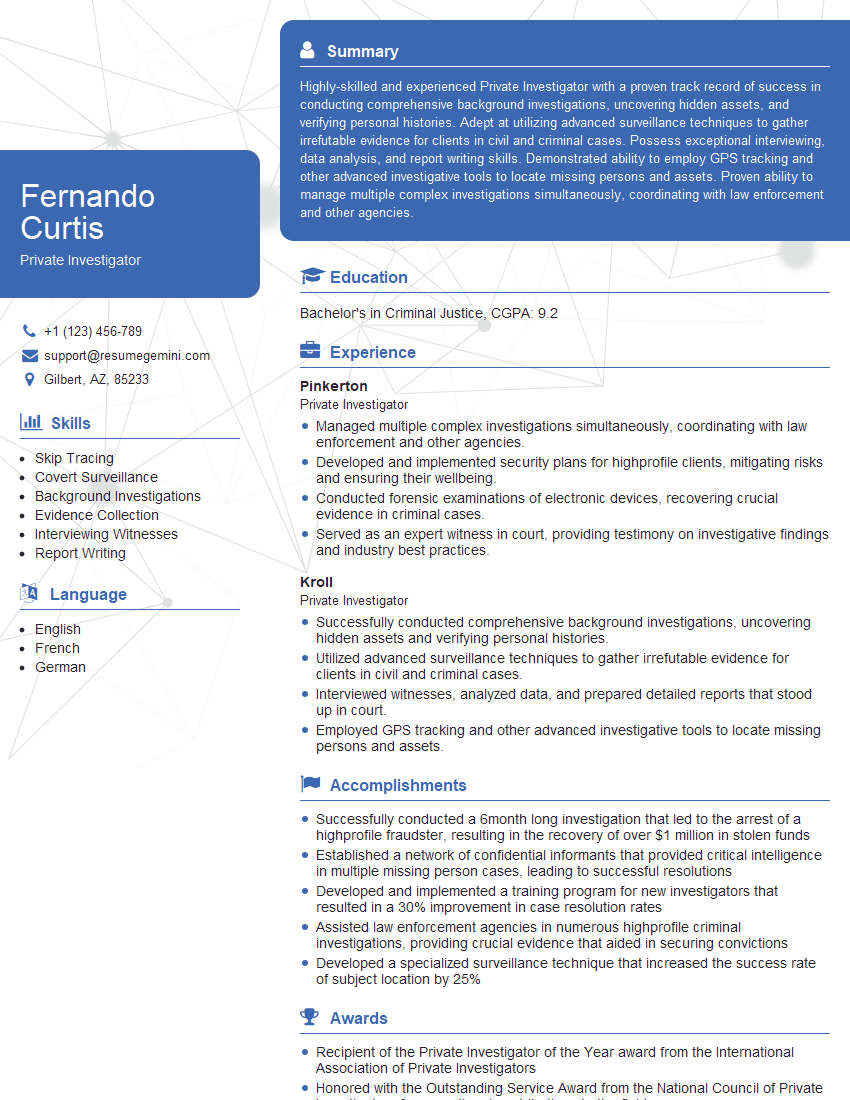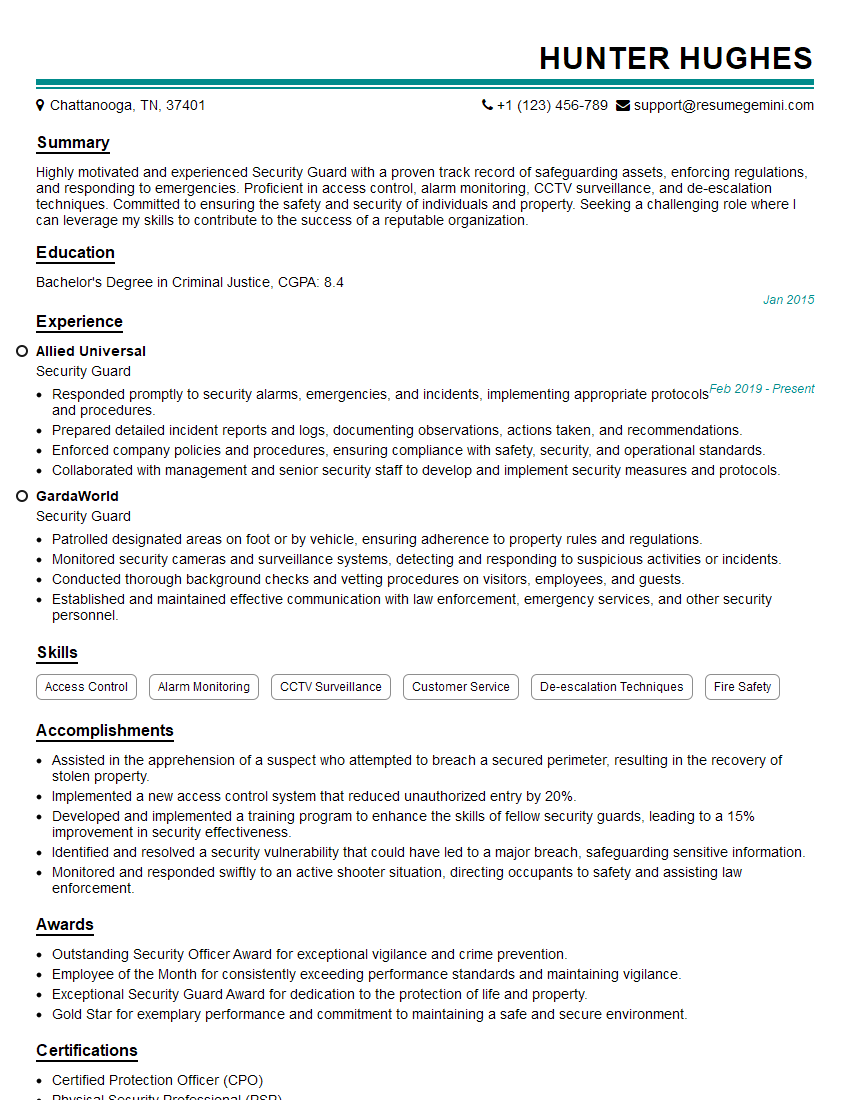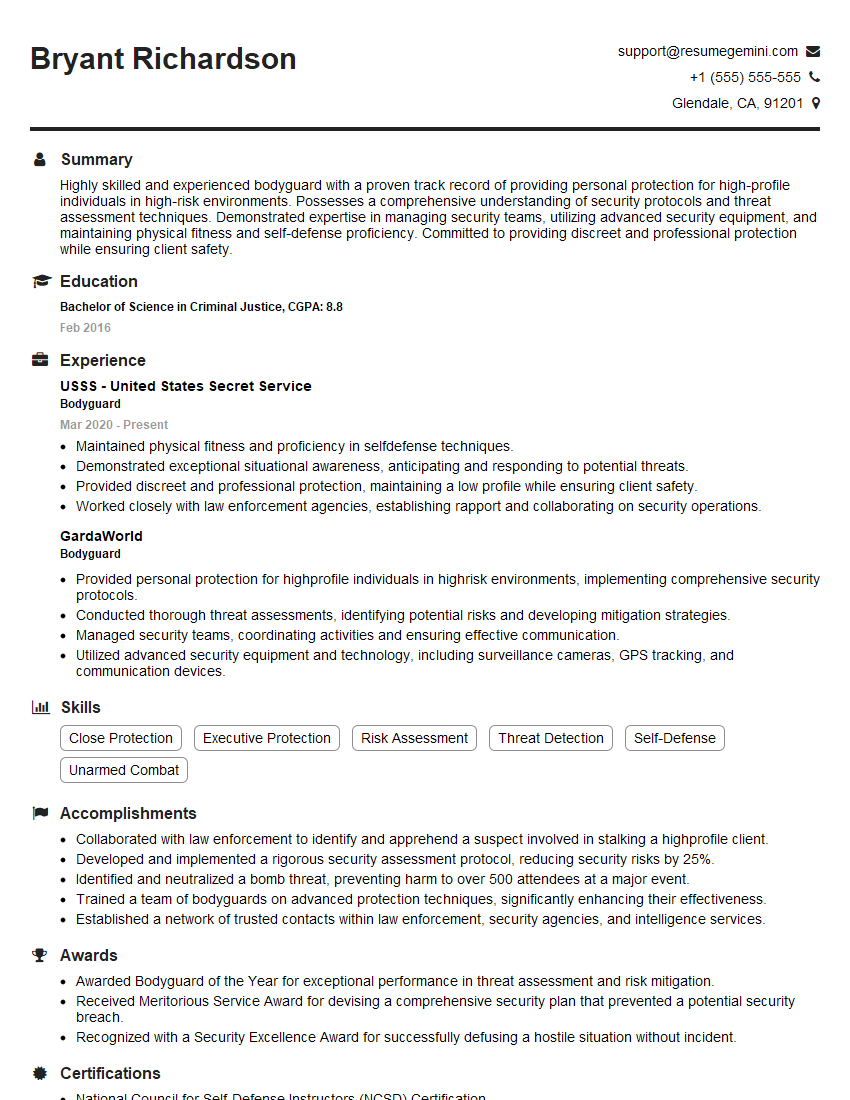Every successful interview starts with knowing what to expect. In this blog, we’ll take you through the top Basic Combat Skills interview questions, breaking them down with expert tips to help you deliver impactful answers. Step into your next interview fully prepared and ready to succeed.
Questions Asked in Basic Combat Skills Interview
Q 1. Describe the proper techniques for hand-to-hand combat.
Effective hand-to-hand combat relies on a combination of striking, grappling, and ground fighting techniques. It’s not about brute strength, but rather precise movements, leverage, and control. Proper techniques prioritize efficiency and minimizing risk of injury to both yourself and your opponent.
Striking: This involves punches, kicks, elbows, and knees. A proper punch uses the entire body, not just the arm, generating power from the ground up. Kicks utilize different parts of the leg for varying impact and range. Elbows and knees are devastating close-range weapons.
Grappling: This focuses on controlling your opponent’s body. Techniques include clinching, takedowns, and joint locks. Clinching allows for controlling distance and delivering strikes. Takedowns bring the fight to the ground. Joint locks aim to control or incapacitate an opponent by manipulating their joints.
Ground Fighting: Once the fight is on the ground, maintaining control and working towards a dominant position is critical. This involves submissions (chokeholds, joint locks) and positional dominance to limit your opponent’s ability to attack.
Example: Instead of throwing a wild punch, a trained fighter would utilize a straight jab, a more controlled and powerful strike, minimizing energy expenditure and maximizing impact.
Q 2. Explain the different types of weapon retention techniques.
Weapon retention is crucial for preventing an attacker from gaining control of your weapon. Techniques vary depending on the weapon type, but the core principle is to maintain a strong grip, use proper body mechanics, and create distance if possible.
Firearm Retention: This involves maintaining a secure grip on the firearm while resisting an attacker’s attempt to disarm you. Techniques include using your support hand to control the attacker’s arm, creating space, and utilizing strong hand grips to prevent disarming attempts.
Knife Retention: Maintaining a strong grip, employing defensive movements and employing counter-attacks are crucial. Keeping the knife blade pointed toward the threat, and using a strong grip combined with body movement to avoid being disarmed is important.
Impact Weapon Retention (e.g., baton, ASP): Similar to firearms, maintaining a strong grip while controlling the attacker’s attempts to disarm is key. The length of the impact weapon often allows for more striking opportunities to create space and disengage.
Example: If someone attempts to grab your firearm, you might use a ‘reactionary retention’ technique, such as a strong grip and a forceful push-pull movement to create distance and maintain control.
Q 3. What are the principles of effective defensive tactics?
Effective defensive tactics prioritize safety and de-escalation. The goal is not to inflict maximum harm but to neutralize the threat while minimizing injury to everyone involved. Key principles include:
Awareness: Maintaining a constant awareness of your surroundings and potential threats.
Avoidance: Avoiding dangerous situations whenever possible.
De-escalation: Attempting to calm the situation and avoid physical confrontation.
Proportionality: Using only the force necessary to neutralize the threat.
Control: Maintaining control of the situation and minimizing collateral damage.
Disengagement: Creating distance and escaping from the situation as soon as it’s safe to do so.
Example: If confronted by an aggressive individual, try to verbally de-escalate the situation before resorting to physical force. If physical force is necessary, aim to disarm or incapacitate the threat with minimum force, and then immediately create distance.
Q 4. How do you assess and neutralize a threat?
Assessing and neutralizing a threat involves a systematic approach:
Assessment: Analyze the situation quickly. Consider the immediate threat level: is the threat armed? How many are there? What is their intent? What are the escape routes?
Prioritize Safety: Ensure your own safety and the safety of others. Create distance if possible. If escape is not feasible, prepare for self-defense.
Neutralization: Use appropriate force to neutralize the threat. This might involve verbal de-escalation, physical restraints, or the use of a weapon, depending on the severity of the threat.
Post-Neutralization Actions: Secure the threat, call for emergency assistance, and provide any necessary first aid. Cooperate fully with law enforcement.
Example: If you encounter someone brandishing a weapon, prioritize escape if possible. If that’s not feasible, create distance while assessing the situation, and then consider using appropriate self-defense measures, if necessary, to neutralize the threat while calling for help.
Q 5. Explain your understanding of situational awareness.
Situational awareness is the ability to constantly scan your environment for potential threats and opportunities. It involves being aware of your surroundings, people around you, and potential hazards. This is a crucial skill for preventing dangerous situations, and responding effectively if one arises.
Observation: Constantly scan your surroundings, noticing details like unusual behavior, potential escape routes, and potential threats.
Listening: Pay attention to sounds in the environment, as they can often provide early warnings of danger.
Analysis: Quickly assess the potential threat level of any situation you observe.
Preemptive Actions: Take preventative measures, like avoiding poorly lit areas or choosing well-traveled routes.
Example: Walking down the street, a situationally aware person would notice a person lurking in a doorway, a parked vehicle blocking the sidewalk, or a sudden change in the crowd’s demeanor, indicating a potential problem before it escalates.
Q 6. Describe your experience with firearms safety and handling.
Firearms safety and handling are paramount. My training emphasizes the ‘four rules’ of firearm safety:
Treat every firearm as if it were loaded.
Never let the muzzle point at anything you are not willing to destroy.
Keep your finger off the trigger until you are ready to shoot.
Be sure of your target and what is beyond it.
Beyond these rules, safe handling includes proper cleaning and maintenance, understanding ammunition types, and practicing safe storage procedures. I have extensive experience in various firearm types, including handguns, rifles, and shotguns, and I’ve maintained a perfect safety record throughout my training and experience.
Example: Before handling any firearm, I always visually and physically check to ensure it is unloaded. Even during training exercises, I maintain a strict adherence to safety protocols.
Q 7. What are the legal considerations surrounding the use of force?
The legal considerations surrounding the use of force are complex and vary by jurisdiction. Generally, the use of force must be justified under the law, often using the concept of ‘reasonable force’. This means the force used must be proportionate to the threat encountered.
Self-Defense: You may use force to defend yourself or others from imminent harm. The force used must be reasonable and necessary to stop the threat.
Duty to Retreat: Some jurisdictions require individuals to retreat if they can safely do so before using force. Others have ‘Stand Your Ground’ laws.
Defense of Property: The use of force to protect property is generally limited, and deadly force is rarely justified.
Imminent Threat: The threat must be immediate and unavoidable for the use of force to be justified.
Example: Using deadly force to stop a robbery is typically justified if there’s an imminent threat to life, while using it to protect property is usually not. It is vital to understand your local laws and regulations concerning the use of force.
Q 8. How would you respond to an active shooter situation?
Responding to an active shooter situation requires immediate action based on the principles of Run, Hide, Fight. The priority is always self-preservation.
- Run: If possible, evacuate the area immediately. Move quickly and quietly to a safe location, away from the shooter. Inform others as you go. This is always the preferred option if feasible.
- Hide: If evacuation isn’t possible, find a secure place to hide. Lock and barricade doors, turn off lights, and silence your phone. Stay quiet and remain out of sight. Consider using heavy furniture to block entry points.
- Fight: As a last resort, if your life is in imminent danger, fight back aggressively with any available object. Aim for the head and neck. This is a desperate measure, and should only be undertaken if running or hiding are not viable options. Teamwork is crucial in this phase; a coordinated effort is significantly more effective.
During the response, maintaining situational awareness is crucial. Listen for sounds, observe the environment, and be prepared to adapt your actions based on the evolving situation. Post-incident, cooperate fully with law enforcement and offer any relevant information you can recall. Remember to seek psychological support if needed – dealing with trauma requires professional help.
Q 9. Explain your knowledge of different types of edged weapons.
Edged weapons vary significantly in design, functionality, and lethality. Understanding their different characteristics is crucial for safety and effective response. Some key types include:
- Knives: These range from simple fixed-blade knives to complex folding knives, each with its strengths and weaknesses. Fixed blades offer greater strength and reliability, while folding knives are more easily concealed. The size, blade shape, and materials used significantly affect their effectiveness.
- Swords: These encompass a wide range of blades, each with unique features. For example, katanas are known for their sharpness and slicing capabilities, while rapiers emphasize thrusting attacks. Proper technique is essential for effective and safe use.
- Daggers and Stilettos: These are primarily designed for thrusting, often employed in close-quarters combat. Their small size enhances concealment, but limits their range of attack.
Beyond the weapon type, understanding the materials used (e.g., steel type, blade geometry) contributes to the assessment of their strength, sharpness, and durability. The study of edged weapons necessitates practical experience and training to manage and use them correctly.
Q 10. Describe the proper techniques for using a baton.
Proper baton techniques emphasize control, precision, and safety. The goal is to incapacitate the threat while minimizing the risk of injury to both the officer and the suspect. Key techniques include:
- Basic Strikes: These include the jab, the strike, and the sweep. The jab is a quick, straight thrust; the strike is a more powerful blow, usually delivered from the side or above; the sweep is a technique used to control limbs.
- Blocking Techniques: Effective blocking requires proper positioning and timing to deflect incoming blows, protecting the officer from injury. The use of the baton as a shield and its mobility are crucial here.
- Control Holds: Once the suspect is incapacitated, using the baton to maintain control is essential until further assistance arrives or until the suspect is subdued.
Training involves extensive practice with both empty-hand and baton drills, emphasizing precision and control. Safety measures, such as proper grip, stance, and follow-through, are vital to prevent accidental injury. The focus is always on proportional force, only using the amount of force necessary to neutralize the threat.
Q 11. How do you maintain physical fitness for combat readiness?
Maintaining combat readiness demands a multifaceted fitness regime encompassing strength, endurance, agility, and flexibility. This isn’t just about physical strength; it involves mental fortitude as well.
- Cardiovascular Training: Running, swimming, or cycling builds endurance, crucial for prolonged exertion in stressful situations.
- Strength Training: Weightlifting and calisthenics develop muscle strength and power, necessary for effective combat maneuvers and weapon handling.
- Agility and Flexibility Training: Exercises like plyometrics and yoga improve speed, coordination, and range of motion, vital for avoiding injury and reacting swiftly.
- Mental Conditioning: Stress management techniques, meditation, and mindfulness practices enhance resilience under pressure. Proper sleep and nutrition are also integral components.
A personalized program, adjusted to individual needs and limitations, is essential. Regular monitoring of progress, coupled with periodic fitness assessments, helps maintain optimal combat readiness.
Q 12. Explain the importance of teamwork in combat scenarios.
Teamwork is paramount in combat scenarios; it significantly increases the chances of success and survival. Effective teamwork relies on several key elements:
- Communication: Clear and concise communication among team members is essential for coordinating actions, sharing information, and responding to changes in the situation. This includes utilizing both verbal and non-verbal communication techniques.
- Coordination: Team members must be able to work together efficiently, anticipating each other’s moves, and supporting each other in a synchronized fashion.
- Trust and Confidence: Mutual trust and confidence among team members are crucial for effective collaboration, especially during high-stress situations. This involves mutual respect for each others’ skills and expertise.
- Shared Goals: A shared understanding of the mission objectives and roles is essential for a unified approach.
Effective teamwork transcends individual skill; it amplifies capabilities, leading to better outcomes than the sum of individual contributions. Examples include coordinated assaults, covering fire, and mutual support during injury.
Q 13. Describe your experience with tactical communication.
Tactical communication is about conveying clear, concise, and unambiguous information in a time-sensitive environment. It goes beyond simple conversation; it’s about precise use of language and efficient information transfer.
- Clarity and Conciseness: Using precise language and avoiding jargon or ambiguity is vital. Every word must convey meaning quickly.
- Situational Awareness: Maintaining awareness of surroundings and the communication context prevents misunderstanding.
- Active Listening: Listening carefully, ensuring understanding, and asking clarifying questions are crucial to avoiding errors.
- Use of Codes and Signals: In certain situations, employing codes or signals enhances security and speed of information transfer.
My experience encompasses practicing clear communication under pressure, using standardized terminology, and adapting communication methods to the specific situation. Effective communication is as important as any tactical maneuver, contributing significantly to mission success and team safety.
Q 14. How do you handle stress and pressure in high-stakes situations?
Handling stress and pressure in high-stakes situations requires a combination of training, mental preparation, and self-awareness. It’s about controlling your response, not eliminating the stress.
- Training: Extensive training simulates high-pressure environments, building resilience and confidence through experience. This reduces the impact of stress in real-world scenarios.
- Mental Preparation: Techniques such as mindfulness, meditation, and visualization help manage anxiety and enhance focus, preparing the mind for stressful situations.
- Self-Awareness: Recognizing personal stress triggers and developing coping mechanisms (deep breathing, controlled movements) helps manage responses during critical moments.
- Teamwork: A strong team provides support and reinforces morale, making stressful situations more manageable.
Developing a robust mental toolkit is crucial for handling pressure effectively. This isn’t about eliminating stress; it’s about developing the resilience to manage it constructively and perform effectively under pressure. Regular self-reflection and continuous learning refine these crucial skills.
Q 15. What are the different types of non-lethal weapons and their applications?
Non-lethal weapons are designed to incapacitate or subdue a threat without causing serious injury or death. Their application depends heavily on the specific situation and the threat level. Choosing the right weapon is crucial to ensure safety and effectiveness.
- Pepper spray: A common self-defense tool that causes temporary blindness, respiratory distress, and skin irritation. Effective at a close range, ideal for deterring an immediate physical attack. Requires careful aim to avoid collateral damage.
- Taser: Delivers a high-voltage electrical shock, causing muscle incapacitation. Useful for controlling aggressive individuals from a slightly longer range than pepper spray. Requires proper training to avoid misuse and potential injury.
- Baton: A blunt impact weapon used for striking or controlling an individual. Requires precise technique to avoid causing excessive harm. Training emphasizes controlled strikes to vulnerable pressure points rather than bone-breaking blows.
- Flashbang grenades: Create a blinding flash and deafening bang, disorienting the target and providing an opportunity for apprehension. Used in tactical situations to gain control over a room or area, but are extremely dangerous to those in close proximity.
- Rubber bullets/beanbag rounds: Fired from firearms, these rounds are designed to incapacitate with blunt force trauma. Used in crowd control situations, but can still cause serious injuries if used incorrectly. Requires precise aiming and a high degree of situational awareness.
The selection of a non-lethal weapon should be based on a careful risk assessment, taking into account the nature of the threat, the environment, and the potential for unintended consequences.
Career Expert Tips:
- Ace those interviews! Prepare effectively by reviewing the Top 50 Most Common Interview Questions on ResumeGemini.
- Navigate your job search with confidence! Explore a wide range of Career Tips on ResumeGemini. Learn about common challenges and recommendations to overcome them.
- Craft the perfect resume! Master the Art of Resume Writing with ResumeGemini’s guide. Showcase your unique qualifications and achievements effectively.
- Don’t miss out on holiday savings! Build your dream resume with ResumeGemini’s ATS optimized templates.
Q 16. Explain your understanding of escape and evasion techniques.
Escape and evasion techniques are crucial for surviving dangerous situations. They involve a combination of planning, awareness, and practical skills. Think of it like a chess game – you need to anticipate your opponent’s moves and plan your escape accordingly.
- Situational awareness: Constantly assessing your surroundings, identifying potential escape routes, and recognizing threats. This includes understanding the terrain, weather conditions, and the capabilities of your pursuer(s).
- Route planning: Identifying multiple escape routes, prioritizing those offering cover and concealment, and avoiding areas where you are easily visible or trapped.
- Movement techniques: Using cover and concealment effectively (discussed later), moving quickly and quietly, and varying your pace and direction to avoid predictability.
- Improvisation: Being resourceful and adaptable in unexpected circumstances. This includes using natural or man-made obstacles to your advantage and modifying your plan as needed.
For example, in an urban environment, you might utilize alleys, rooftops, or underground passages. In a wilderness setting, knowledge of natural terrain and the ability to blend with the environment are vital.
Q 17. How do you conduct a proper search of a person or area?
Searching a person or area is a systematic process that ensures thoroughness and safety. The approach varies depending on the situation – a pat-down search for weapons is different from a more detailed search of a building.
- Person search (pat-down): This should be conducted in a safe manner with the person facing away and hands visible. The search should focus on areas where weapons might be concealed (pockets, waistband, etc.). Maintain a safe distance and be aware of potential reactions.
- Area search (building): This requires a methodical approach, often starting with the perimeter and moving inwards. Common search patterns include spiral, grid, and zone searches, chosen depending on the size and layout of the area. Use a flashlight for illumination in low-light conditions. Communicate with your team clearly throughout the search.
Always prioritize safety during a search. Maintain a tactical stance, be aware of your surroundings, and communicate potential hazards to your team. The goal is to efficiently locate potential threats while minimizing risk.
Q 18. Describe your experience with first aid and emergency medical response.
My first aid and emergency medical response training includes [insert specific certifications and experience, e.g., Advanced First Aid/CPR/AED certification, combat lifesaver course completion, etc.]. I have practical experience in [mention specific scenarios, e.g., treating traumatic injuries in a field environment, providing immediate care in high-stress scenarios].
My expertise encompasses the assessment of injuries (ABCs – airway, breathing, circulation), wound management (bleeding control, dressing application), and stabilization of patients pending evacuation or arrival of professional medical personnel. I am proficient in using various medical equipment and supplies, including tourniquets, splints, and oxygen.
Remember, in emergency situations, speed and efficiency are paramount, but always prioritize safety for both yourself and the injured person.
Q 19. Explain the principles of cover and concealment.
Cover and concealment are vital for personal safety during combat or other dangerous situations. They represent different levels of protection from enemy fire.
- Cover: Provides physical protection from enemy fire. Examples include brick walls, concrete barriers, and vehicles that can withstand bullets or shrapnel.
- Concealment: Hides you from enemy view, but doesn’t necessarily provide protection from enemy fire. Examples include bushes, tall grass, and shadows. Concealment might make you less likely to be seen, but a bullet will still penetrate.
Imagine playing hide-and-seek. Concealment is hiding behind a bush – you’re hidden, but still vulnerable. Cover is hiding behind a solid brick wall – you’re both hidden and protected.
Effective use of both requires careful observation, understanding of the threat, and rapid adaptation to changing circumstances.
Q 20. How do you plan and execute a tactical maneuver?
Planning and executing a tactical maneuver requires careful consideration of various factors, and a robust framework.
- Intelligence gathering: Understanding the objective, the terrain, and the enemy’s capabilities. This might involve reconnaissance or reviewing available intelligence.
- Planning the maneuver: Defining the objective, selecting the route, and assigning roles and responsibilities within the team. This might involve creating a sketch or map of the area.
- Communication: Maintaining clear communication throughout the maneuver to ensure coordination and awareness. Hand signals, radios, or even pre-determined cues can play crucial roles.
- Execution: Moving quickly and efficiently, maintaining situational awareness, and adapting to unexpected situations. This phase is all about carrying out the plan.
- Debrief: Analyzing the success or failure of the maneuver, identifying areas for improvement, and extracting lessons learned for future operations. This ensures continuous improvement.
For instance, a building clearing operation would require careful planning of entry points, communication methods, and search patterns, all while maintaining awareness of potential threats.
Q 21. What are the different types of camouflage and concealment techniques?
Camouflage and concealment aim to minimize visibility and enhance survival by blending with the environment. Techniques vary according to the setting.
- Camouflage patterns: Utilizing disruptive patterns on clothing or equipment to break up the human form and blend with the background. This is often achieved through the use of natural earth tones and irregular shapes.
- Natural materials: Using foliage, mud, and other natural materials to obscure equipment and body outlines. This is particularly effective in vegetation-rich environments.
- Painting and dyeing: Using paints or dyes to match clothing and equipment to the specific terrain. This requires understanding the specific colors and textures of the environment.
- Ghillie suits: Specialized clothing incorporating natural materials and camouflage patterns for advanced concealment in a wide range of environments. These provide excellent camouflage, often requiring hours of setup.
- Positional concealment: Utilizing natural features such as rocks, trees, and shadows to break up the outline of oneself. This can often be more effective than relying on camouflage patterns alone. It relies on a deep understanding of light, shadow and the environment.
Choosing the right camouflage technique depends on the specific environment. A desert camouflage pattern is useless in a jungle, and vice versa.
Q 22. How do you identify and respond to improvised explosive devices (IEDs)?
Improvised explosive devices (IEDs) are a significant threat in combat situations. Identifying and responding to them requires a systematic approach combining observation, caution, and established procedures. First, suspicious objects are the primary indicator. This could include anything out of place, like a buried container, an unusual package, or wires exposed in an unexpected location. Remember, curiosity killed the cat. Never approach a suspected IED directly.
The response follows a standard operating procedure (SOP). This typically involves establishing a cordon to secure the area, preventing unauthorized access. Then, a thorough reconnaissance is performed from a safe distance, utilizing binoculars or other observation tools to analyze the object. Explosives ordnance disposal (EOD) specialists are the primary responders, utilizing specialized equipment and techniques to safely neutralize the threat. My training emphasizes maintaining a safe distance and waiting for the EOD team. Any attempt to disarm or manipulate an IED without proper training is extremely dangerous and should never be undertaken. We are trained to call for specialists, not become specialists ourselves.
For example, during my deployment, we encountered a suspicious bag near a frequently used patrol route. Following SOP, we immediately secured the area, notified our command, and waited for the EOD team to arrive. Their careful examination confirmed it was a viable IED, saving lives and preventing potential harm.
Q 23. Explain your understanding of land navigation.
Land navigation is the ability to accurately determine one’s location and move to a desired point using a map, compass, and other tools, even without readily visible landmarks. This skill is crucial in combat and other outdoor scenarios where GPS may be unavailable or unreliable. It relies on understanding map reading, compass use, and terrain association.
Effective land navigation begins with orienting the map – aligning its north with the magnetic north indicated by the compass. Next, understanding the terrain’s features – hills, valleys, streams – allows you to accurately locate yourself on the map by identifying recognizable landmarks. We use techniques like resection and intersection to pinpoint our precise location. Once the location is determined, planning a route involves identifying checkpoints and considering terrain challenges. Pace counting is essential for estimating distance covered, while using the compass ensures maintaining bearing to the destination. Regular checks against the map and compass maintain accuracy throughout the journey. A back azimuth, the reverse bearing to the origin, assists in navigation back to a starting point.
In a practical exercise, I successfully navigated a 10km route in challenging terrain using only a map, compass, and protractor, achieving a final location within 50 meters of the target. This involved planning an efficient route, accounting for terrain features, and continually verifying our position.
Q 24. Describe your experience with close-quarters combat (CQC).
Close-quarters combat (CQC) involves fighting at extremely close range, often in confined spaces. My training in CQC emphasizes a combination of hand-to-hand techniques, weapon manipulation, and tactical awareness. We focus on rapid weapon deployment, effective use of cover and concealment, and neutralizing threats quickly and decisively within the limited space. Situational awareness is paramount. Knowing your surroundings allows you to plan for movement, anticipate enemy actions, and leverage the environment to your advantage.
Specific techniques include various forms of grappling, striking, and weapon disarms. Furthermore, training emphasizes the controlled and lethal application of force to overcome threats. We’re trained to transition seamlessly between hand-to-hand combat and the effective use of firearms or other weapons within the close-quarters scenario. Effective CQC requires immense discipline, precision, and the ability to make split-second decisions under immense pressure. We practice scenarios in confined spaces, simulating real-world situations to build confidence and proficiency.
For instance, during training, we practiced clearing a simulated room utilizing team maneuvers, controlling the angles of approach, and utilizing cover and concealment. Each individual’s skill and preparedness are crucial to ensure both the team’s and individual’s safety.
Q 25. How do you assess and mitigate risk in a combat environment?
Risk assessment and mitigation in combat is a continuous process. It begins with identifying potential threats – enemy forces, IEDs, environmental hazards. Then, we analyze the likelihood and severity of each threat. This process involves collecting intelligence, understanding the operational environment, and utilizing the experience of the team. This information informs the development of mitigation strategies.
Mitigation involves implementing measures to reduce or eliminate identified risks. This might include choosing a specific route to avoid known enemy positions, reinforcing defensive positions, conducting thorough reconnaissance, or employing camouflage and concealment. Contingency planning is crucial. Anticipating potential problems and planning for different scenarios is vital. This ensures we are prepared to respond to unforeseen circumstances or changes in the situation.
For example, during a patrol, we identified a potential ambush point. We responded by adjusting our patrol route, deploying scouts ahead, and maintaining heightened vigilance. These actions helped to mitigate the risk of an ambush and ensure the safe completion of our mission.
Q 26. What are the ethical considerations of using force?
The ethical use of force is paramount. It’s governed by national and international laws and rules of engagement (ROE). ROE dictate when and how force can be used, emphasizing proportionality, necessity, and discrimination. Proportionality means the force used should be proportionate to the threat; necessity implies using force only when absolutely necessary; and discrimination requires targeting only combatants and avoiding civilian casualties.
Ethical considerations extend beyond ROE. We must constantly evaluate our actions, ensuring compliance with the laws of armed conflict, and striving to minimize collateral damage. We are trained to uphold the highest ethical standards, even in high-stress combat situations. This involves making difficult decisions, accepting the responsibility for our actions, and acknowledging the human cost of warfare. We have to be mindful that even justifiable force can result in unintended consequences.
For instance, during an operation, we encountered civilians in the vicinity of the enemy. We refrained from taking action that could endanger the civilians, even though it meant taking increased risk to ourselves. The well-being and safety of non-combatants is of the utmost importance.
Q 27. Explain your understanding of different combat formations.
Combat formations are tactical arrangements of troops designed to achieve specific objectives, maximizing effectiveness and minimizing vulnerability. The choice of formation depends on the mission, terrain, and the anticipated enemy actions. Common formations include:
- Line formation: Provides maximum firepower across a wide front, ideal for open terrain.
- Column formation: Best for moving troops along narrow paths or roads, minimizing the exposed front.
- Wedge formation: Used for breaking through enemy lines or advancing into confined spaces.
- Vee formation: Used to protect flanks while advancing.
- Squad formations: Smaller tactical units that allow for different arrangements depending on the tactical situation.
The selection of the formation is a dynamic process; the leader will adjust formations according to the changing circumstances. My experience encompasses both leading and operating within various formations, adapting to diverse tactical requirements and terrain characteristics. Effective communication and coordination within the formation are crucial for success. Training emphasizes quick transitions between formations to maintain agility and responsiveness.
Q 28. Describe your experience with military or law enforcement procedures.
My experience includes extensive training and practical application of military and law enforcement procedures. This encompasses a wide range of protocols, including search and seizure techniques, proper handling and use of firearms, emergency response procedures, and reporting mechanisms. I am proficient in following chain of command, maintaining proper documentation, and adhering to strict operational guidelines. Detailed training on rules of engagement, use of force policies, and de-escalation techniques are crucial aspects of this training. My practical experience includes several operations where meticulous adherence to procedure ensured the success of the mission while upholding the highest standards of safety and ethical conduct. All activities are logged and reported according to official standards, maintaining a high level of accountability.
For example, during a high-risk search and seizure operation, we meticulously adhered to the established protocols, resulting in a successful outcome without any injuries or violations of procedure. Thorough documentation and reporting ensured transparency and accountability for our actions.
Key Topics to Learn for Basic Combat Skills Interview
- Weapon Handling and Maintenance: Understand the theoretical principles of safe weapon handling, cleaning, and maintenance procedures. Be prepared to discuss practical applications, such as malfunction clearing and preventative maintenance.
- Marksmanship and Fire Control: Explain the theoretical concepts behind accurate shooting, including sight alignment, trigger control, and breathing techniques. Discuss practical experience in various firing positions and target engagement scenarios. Consider the impact of different environmental factors on marksmanship.
- Fieldcraft and Navigation: Demonstrate understanding of land navigation techniques, including map reading, compass use, and terrain association. Explain practical applications like route planning and avoiding detection. Explore advanced topics like GPS utilization and night navigation.
- First Aid and Combat Casualty Care: Discuss the theoretical framework of casualty care in combat environments. Be ready to explain practical procedures for treating common injuries, including wound dressing, splinting, and evacuation strategies. Consider the challenges of providing care under stress.
- Teamwork and Communication: Explain the importance of clear and concise communication in a combat setting. Discuss the practical applications of teamwork, including leadership, followership, and coordinated maneuvers. Explore how effective communication under pressure contributes to mission success.
- Physical Fitness and Endurance: Discuss the importance of physical fitness for combat readiness, including stamina, strength, and agility. Be prepared to discuss practical training methods and the impact of physical conditioning on overall performance.
Next Steps
Mastering Basic Combat Skills is crucial for career advancement within the military and related fields. It demonstrates your commitment to professional development and your ability to handle challenging situations. To significantly boost your job prospects, create an ATS-friendly resume that effectively highlights your skills and experience. ResumeGemini is a trusted resource to help you build a professional and impactful resume. We offer examples of resumes tailored to Basic Combat Skills to guide you through the process. Invest the time to craft a compelling resume – it’s your first impression on potential employers.
Explore more articles
Users Rating of Our Blogs
Share Your Experience
We value your feedback! Please rate our content and share your thoughts (optional).
What Readers Say About Our Blog
Hello,
We found issues with your domain’s email setup that may be sending your messages to spam or blocking them completely. InboxShield Mini shows you how to fix it in minutes — no tech skills required.
Scan your domain now for details: https://inboxshield-mini.com/
— Adam @ InboxShield Mini
Reply STOP to unsubscribe
Hi, are you owner of interviewgemini.com? What if I told you I could help you find extra time in your schedule, reconnect with leads you didn’t even realize you missed, and bring in more “I want to work with you” conversations, without increasing your ad spend or hiring a full-time employee?
All with a flexible, budget-friendly service that could easily pay for itself. Sounds good?
Would it be nice to jump on a quick 10-minute call so I can show you exactly how we make this work?
Best,
Hapei
Marketing Director
Hey, I know you’re the owner of interviewgemini.com. I’ll be quick.
Fundraising for your business is tough and time-consuming. We make it easier by guaranteeing two private investor meetings each month, for six months. No demos, no pitch events – just direct introductions to active investors matched to your startup.
If youR17;re raising, this could help you build real momentum. Want me to send more info?
Hi, I represent an SEO company that specialises in getting you AI citations and higher rankings on Google. I’d like to offer you a 100% free SEO audit for your website. Would you be interested?
Hi, I represent an SEO company that specialises in getting you AI citations and higher rankings on Google. I’d like to offer you a 100% free SEO audit for your website. Would you be interested?
good
